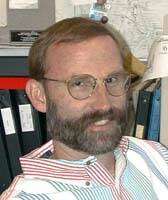Phil Christensen
Philip Russel Christensen (born 1953) is a geologist whose research interests focus on the composition, physical properties, processes, and morphology of planetary surfaces, with an emphasis on Mars and the Earth. He is currently a Regents' Professor and the Ed and Helen Korrick Professor of Geological Sciences at Arizona State University (ASU).[1]
Phil Christensen | |
|---|---|
 photo courtesy NASA/JPL-Caltech (2005) | |
| Born | 1953 |
| Nationality | United States |
| Alma mater | University of California, Los Angeles |
| Scientific career | |
| Fields | Planetary geology |
| Institutions | Arizona State University |
Education
Christensen earned his B.S. degree in Geology from the University of California, Los Angeles in 1976. He earned his M.S. in 1978 and his Ph.D. in 1981 in Geophysics and Space physics, both from the University of California, Los Angeles.
Career
Along with serving on the faculty of the Department of Geology at Arizona State University since 1981, Christensen is the principal investigator for the Mars Global Surveyor Thermal Emission Spectrometer (TES), the Mars Odyssey THEMIS, the Europa Clipper Europa Thermal Emission Imaging System instruments, as well as a co-investigator for the Mars Exploration Rovers, responsible for the Mini-TES instruments. He also serves on the research staff of the Center for Meteorite Studies museum on the ASU campus and is the director of the Mars Space Flight Facility.
His discovery (based on Thermal Emission Spectrometer data) of crystalline hematite in Meridiani Planum was instrumental in that area's choice as the landing site for the Mars Exploration Rover Opportunity.
Awards and honors
- Christensen was awarded the Exceptional Scientific Achievement Medal by NASA in 2003, and was elected as a Fellow of the American Geophysical Union in 2004.
- In September, 2009, he served as chair of the Mars Panel of the National Research Council's 2013-2022 Decadal survey[2] on planetary science.
- Asteroid 90388 Philchristensen, discovered by the Catalina Sky Survey in 2003, was named in his honor.[1][3] The official naming citation was published by the Minor Planet Center on 12 July 2014 (M.P.C. 89085).[4]
- In August, 2018, he was awarded the Whipple Award by AGU for his contributions to planetary science.[5]
References
- "(90388) Philchristensen". Minor Planet Center. Retrieved 22 January 2020.
- "Space scientists meet at ASU to plan Mars exploration | ASU Now: Access, Excellence, Impact". ASU news – Arizona State University. 2009-09-04. Retrieved 22 January 2020.
- "Asteroids named for 2 ASU professors". 3TV. Phoenix, Arizona. March 11, 2016. Archived from the original on 20 September 2016.
- "MPC/MPO/MPS Archive". Minor Planet Center. Retrieved 22 January 2020.
- "2018 AGU Section Awardees and Named Lecturers". AGU. Retrieved 22 January 2020.
External links
- Philip R. Christensen, Curriculum Vitae
- Philip R. Christensen, Arizona State University – School of Earth and Space Exploration
- Phil Christensen's homepage
- TES Instrument Homepage
- THEMIS Instrument Homepage
- MTES Instrument Homepage
- OTES (OSIRIS-REx Thermal Emission Spectrometer) instrument homepage